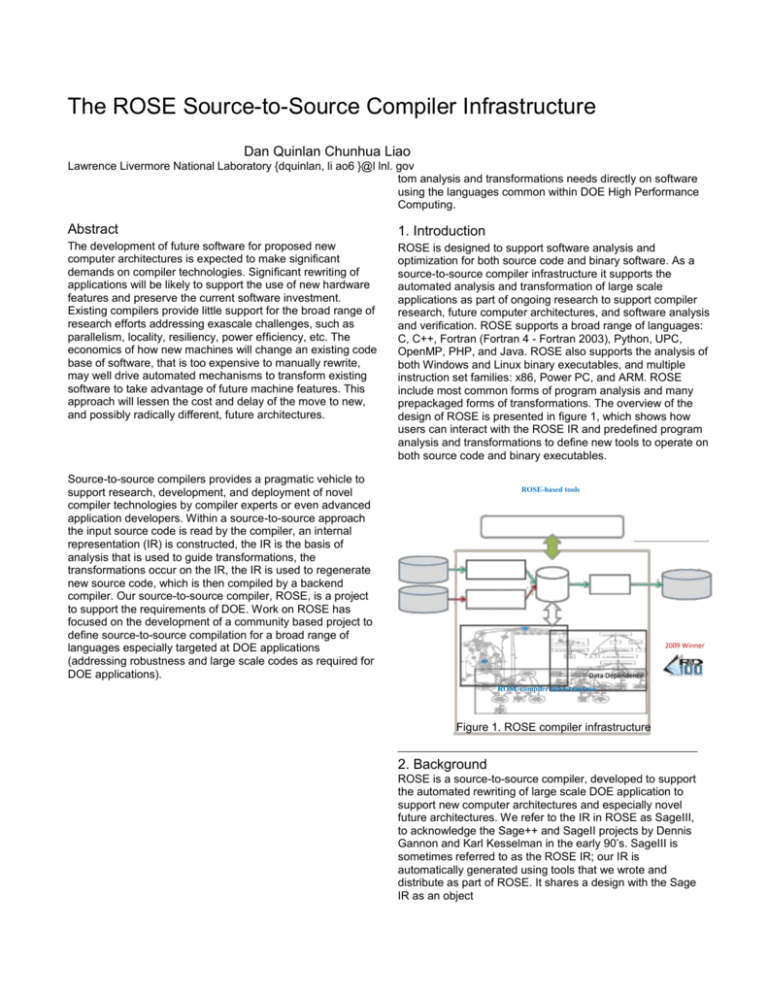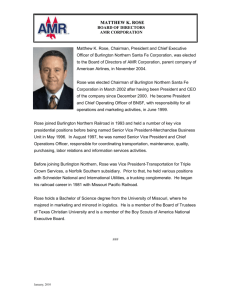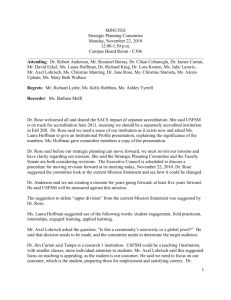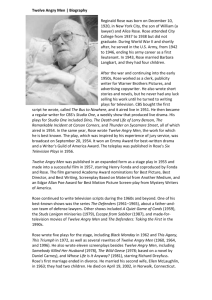The ROSE Source-to-Source Compiler Infrastructure Dan Quinlan
advertisement

The ROSE Source-to-Source Compiler Infrastructure
Dan Quinlan Chunhua Liao
Lawrence Livermore National Laboratory {dquinlan, li ao6 }@l lnl. gov
tom analysis and transformations needs directly on software
using the languages common within DOE High Performance
Computing.
Abstract
1. Introduction
The development of future software for proposed new
computer architectures is expected to make significant
demands on compiler technologies. Significant rewriting of
applications will be likely to support the use of new hardware
features and preserve the current software investment.
Existing compilers provide little support for the broad range of
research efforts addressing exascale challenges, such as
parallelism, locality, resiliency, power efficiency, etc. The
economics of how new machines will change an existing code
base of software, that is too expensive to manually rewrite,
may well drive automated mechanisms to transform existing
software to take advantage of future machine features. This
approach will lessen the cost and delay of the move to new,
and possibly radically different, future architectures.
ROSE is designed to support software analysis and
optimization for both source code and binary software. As a
source-to-source compiler infrastructure it supports the
automated analysis and transformation of large scale
applications as part of ongoing research to support compiler
research, future computer architectures, and software analysis
and verification. ROSE supports a broad range of languages:
C, C++, Fortran (Fortran 4 - Fortran 2003), Python, UPC,
OpenMP, PHP, and Java. ROSE also supports the analysis of
both Windows and Linux binary executables, and multiple
instruction set families: x86, Power PC, and ARM. ROSE
include most common forms of program analysis and many
prepackaged forms of transformations. The overview of the
design of ROSE is presented in figure 1, which shows how
users can interact with the ROSE IR and predefined program
analysis and transformations to define new tools to operate on
both source code and binary executables.
Source-to-source compilers provides a pragmatic vehicle to
support research, development, and deployment of novel
compiler technologies by compiler experts or even advanced
application developers. Within a source-to-source approach
the input source code is read by the compiler, an internal
representation (IR) is constructed, the IR is the basis of
analysis that is used to guide transformations, the
transformations occur on the IR, the IR is used to regenerate
new source code, which is then compiled by a backend
compiler. Our source-to-source compiler, ROSE, is a project
to support the requirements of DOE. Work on ROSE has
focused on the development of a community based project to
define source-to-source compilation for a broad range of
languages especially targeted at DOE applications
(addressing robustness and large scale codes as required for
DOE applications).
ROSE-based tools
2009 Winner
Data Dependence
ROSE compiler infrastructure
Figure 1. ROSE compiler infrastructure
2. Background
ROSE is a source-to-source compiler, developed to support
the automated rewriting of large scale DOE application to
support new computer architectures and especially novel
future architectures. We refer to the IR in ROSE as SageIII,
to acknowledge the Sage++ and SageII projects by Dennis
Gannon and Karl Kesselman in the early 90’s. SageIII is
sometimes referred to as the ROSE IR; our IR is
automatically generated using tools that we wrote and
distribute as part of ROSE. It shares a design with the Sage
IR as an object
IR
(AST)
Unparse
r
www.ro s e Co mpile
r.o rg
Binary
Disassembler
System
Dependence
C/C++/Fortran
Source Code
EDG Front-end/ Open
Fortran Parser
Control Flow
Software
B
Novel research areas are most easily supported when they
can leverage significant tool chains that interact and use
source code while allowing the hardware vendor’s own
compiler for low level optimizations. In fact, high level
optimization are rarely feasible for existing low level compilers
for common languages such as C, C++, and Fortran. ROSE
addresses the economics of how compiler research can be
moved closer to the audience with significant technical
performance problems and for whom the hardware is likely to
be changing significantly in the next decade. Within ROSE it is
less the goal to solve all problems than to permit domain
experts to better solve their own problems. This talk will focus
on the design and motivation for ROSE as an open
community source-to-source compiler infrastructure to support
performance optimization, tools for analysis, verification and
software assurance, and general cus[Copyright notice will appear here once ’preprint’ option is removed.]
1 2011/9/2
i
n
a
r
y
Transforme
d Code
• Multiple mailing lists: public, developers, core staff
oriented IR that closely follows the specification of the
•
grammar for the different languages that are supported.
Basis for numerous compiler and tools projects
•
Modifications to the IR are typically done through
worldwide
modifications of the inputs to ROSETTA; the tool we wrote to
• About 80% of source code IR nodes are shared between
generate the IR. A significant emphasis in ROSE has been on
all languages
automation and code generation.
About 10% of IR nodes are devoted to specialized corner
ROSE supports the generation of the source code for the
•
cases that are relatively rare in the AST. Common IR
IR so that it can support a large number of IR nodes required
for multilanguage source to source and binary analysis across
• nodes in the AST are used by most of the supported
modern instruction sets. Automated code generation of the IR
• languages.
source code permits embedding sophisticated features into
• The AST represents more structure of the software than
• semantics
the design of the IR: attribute grammar based traversals,
•
memory handling for IR node pools, internal analysis support,
• Two external software repositories (GIT and SVN)
AST copy support, AST merge, AST serialization, etc.
• Approximately 6000 downloads to date
A property of the design of the IR is that it saves all possible
information about the input software (source code or binary).
Released publicly on the web for 3 years
An explicit goal is to unify the handling of source code and
BSD license
binary analysis and support software analysis generally. Most
2009 R&D Award
work goes into the representation of the software within
Largest AST held in memory for analysis: 10 million lines of
ROSE, the output of software to generate code is generally
code (over a hundred million IR nodes, serialized to a
straight forward and requires little or no analysis. A significant
single 15 Gig file) AST traversal time was about 20
focus is on supporting the transformation of the internal
seconds
Abstract Syntax Tree (AST). Unlike most compilers which
Source code position information for every aspect of
target a sophisticated compiler audience, ROSE defines a
code (unoptimized this consumes 25% of the space for
broader audience of tool developers dominantly. Though
the AST)
clearly the more sophisticated tools and ambitions can require
significant compiler background.
A large number of IR nodes are supported within ROSE,
3. Analysis
about half to support source code and the other half for
binary analysis. ROSE supports a wide range of languages
and contains relatively small numbers of IR nodes that are
language specific.
• Support for six serial languages (source code) and three
We have developed a set of analyzes on top
instruction set families (binary analysis)
AST. They are designed to be utilized by use
•
function calls to interfaces. The program ana
Support
for
two
parallel
languages
(UPC
and
OpenMP)
•
include control flow analysis, data flow analy
• IR support for Dwarf debug format
def-use chain, reaching definition, side effec
Supports over three thousand types of machine
etc.), call graph analysis, class hierarchy ana
•
A few general details about
instructions (x86, Power PC, and ARM)
dependence and system dependence analys
ROSE:
communication pattern analysis.
700 IR nodes in ROSE: 350 IR nodes for source code and
In particular two control flow graphs are p
about
350
for
binary
analysis
(significant
space
savings
•
virtual control flow graph and static control fl
from rich type system of the IR).
virtual control flow graph (VCFG) is generate
ROSE is about 1.5 million lines of code 700K of
accommodate frequent AST transformations
automatically generated code 300K of EDG code
is ever created: only the particular CFG node
(distributed as a binary) 500K of hand written code (not
used in a given program ever exist. CFG nod
counting ROSETTA and
value classes (they are copied around by va
•
inputs to ROSETTA)
need for explicit memory management). The
•
ROSE is a DOE funded project for the last 8 years
graph is generated from VCFG and stored e
designed to avoid overhead of dynamically g
Every commit from a user branch to the main trunk is
• tested for about 50 machine hours (run in parallel, this
control flow for AST with no or rare changes
control flow is expressed at statement and e
occurs more quickly).
•
They reflect short-circuited logical and condi
Release tests take another 20 machine hours (run in
properly. It assumes operands of expression
parallel this occurs more quickly).
leftto-right order, unlike the actual language
Personnel over the history of the project include: three
however.
research staff two professional programmers 5 post-docs
Our compiler research also includes form
70 students have been a part of of the project over the last
common to performance optimization and st
8
methods; such as SMT solvers, and symboli
•
years.
abstract interpretation. These forms of analy
Hundreds of pages of on-line documentation
opportunity to be used to support proof base
establish properties that may suevolving machine architectures. Such work also opens the
prove important to verification ofppopportunity to support automated low level verification of
software for correct use of novelorti
software against complex future constraints for power
hardware features in the future. ngoptimization, correct use of complex programming models,
This work expands the range ofHP
and transformations to support increased resiliancy for
analysis avaiable in ROSE and C future HPC.
explores its usefulness to
on
2 2011/9/2
4. Transformation and Optimization
ROSE provides different levels of interfaces
building code transformation via manipulatin
level interfaces are recommended to use wh
possible for their simplicity.
Low level interfaces can give users the maximum freedom to
manipulate some details in AST trees. We also create a wide
range of transformation and optimization functions to
demonstrate the use of the APIs. Users can further reuse
these existence functions to build more complex or
customized transformations and optimizations.
Power (Watt) MFLOPS/Watt
6
250
5
200
4
3
150
2
100
The low level AST interface exposes
member functions of different types of
objects in AST, including the tree
nodes, symbol tables, attributes,
preprocessing information, file
location information, and so on. This
level of interface provides users the
maximum freedom to change the
AST. But using such a low level
interface is a tedious and error-prone
process since users have to manually
create the edges between nodes and
maintain the consistence between the
tree and the corresponding symbol
tables. An AST consistency test
function is provided to check the
transformed AST is complete and
consistent.
1
0
50
0
1 2 4 6 8 10 12 14 16
Number of threads
6. Results
Numerous tools are available in ROSE, such
as 1. Auto parallelization tools for HPC,
References
The high level AST interface contains a set of functions toare also used to further improve the quality of the outlining so the
generated function preserves the original semantics and
build AST subtrees and insert them into existing AST. A lot of
performance characteristics.
helper functions are also provided to walk the tree, query
nodes, replace, delete, or even copy subtrees. Using the high
level interface, users only need to provide essential source
5. Enabling Exascale Research
code information as parameters to these functions. All details
ROSE is being used by several DOE projects to address the
of edges and symbol tables are automatically and
challenges of exascale computing. One of the projects, Thrify,
transparently handled by the interface. The high level interface
is using ROSE to explore novel compiler analysis and
also support different order of AST constructions. Users can
optimization to take advantage of an exascale architecture
either build parent nodes first or build children nodes first. Or
with many-core chips specially designed to improve
statements using some variables can be even build before the
performance per watt. In another project, CODEX, an
declaration statements are created. The high level interface is
alternative simulator is used to support the analysis of kernels
able to automatically patch up AST and symbol tables once
from DOE applications using other proposed exascale node
enough information is available.
architectures and possible future network connection
We have developed a wide range of transformations and
topologies and hardware. In still another project, ROSE has
optimizations in ROSE, including partial redundancy
been used to analyze example applications and extract the
elimination, constant folding, inlining, outlining (separating out
MPI usage as an input code to support evaluation of message
a portion of code as a function), OpenMP 3.0 implementation
passing to support the network communication simulation.
[2], automatic parallelization [3] and loop transformations,
This work is part of a project to automate how co-design can
such as fusion, fission, interchange, unrolling, and blocking.
be applied to support the evaluation of DOE applications.
For example, the ROSE outliner [1] can extract code portions
of C, C++ and Fortran into functions. It supports the classic
way of generating one function parameter for each variable to
be passed in or out of the generated function. It also can
optionally wrap multiple variables into an array and use the
array as a single function parameter. More importantly, the
ROSE outliner differentiates the usage of parameters into
useby-value and use-by-address. So the classic outlining
algorithm’s excessive pointer dereferences (used to access
written parameters) can be largely eliminated if the accesses
to the written parameters are substituted by their value clones.
Other analyses, such as liveness analysis and scope analysis
Figure 2. OpenMP transformations using ROSE and their
2. OpenMP compiler, 3. Exascale Co-design
skeleton generator, 4. ROSE-CIRM (Runtime error
detection support), 5. Tools for the analysis of MPI,
6. Tools to enforce data integrity for Exascale
architectures. 7. Binary emulation to support
general analysis, 8. Compass static analysis tool,
9. Data structure visualization (to support
debugging) and 10. Program Visualization.
Separate from the tools provided in ROSE, and the
tools that external groups have built using ROSE,
ROSE is itself a tool for building software analysis and
optimization tools. Is is used as a basis for both
graduate courses in a wide range of topics from
compiler construction and analysis to software
assurance. ROSE is released under a BSD license to
support as low a barrier to adoption as possible for
industrial use.
[1] Chunhua Liao, Daniel J. Quinlan, Richard Vuduc, and
Thomas Panas. Effective source-to-source outlining to support
whole program empirical optimization. In The 22th
International Workshop on Languages and Compilers for
Parallel Computing (LCPC) , Newark, Delaware, USA, 2009.
[2] Chunhua Liao, Daniel J. Quinlan, Thomas Panas, and
Bronis R. de Supinski. A ROSE-based OpenMP 3.0 research
compiler supporting multiple runtime libraries. In Mitsuhisa
Sato, Toshihiro Hanawa, Matthias S. M ¨ uller, Barbara M.
Chapman, and Bronis R. de Supinski, editors, IWOMP, volume
6132 of LNCS, pages 15–28. Springer, 2010. ISBN
978-3-642-13216-2. doi: 10.1007/978-3-642-13217-9 2.
[3] Chunhua Liao, Daniel J. Quinlan, Jeremiah Willcock, and
Thomas Panas. Semantic-aware automatic parallelization of
modern applications using high-level abstractions.
International Journal of Parallel Programming,
38(5-6):361–378, 2010.
3 2011/9/2
MFLOPS/Watt
Figure 2 shows the evaluation of both power and
MFLOP per Watt using a node simulator and for
different numbers of threads. All transformations were
done using ROSE. The simulator represents a
proposed future node architecture.
Watt
evaluation using a simulator on a numerical kernel (Jacobi
Iteration) for both power and MFLOP/Watt.







